Mobile Safari: 9 Night Botswana Highlights
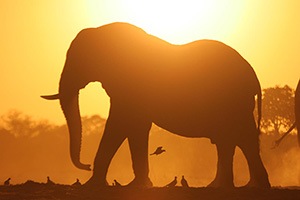
Duration: 10 days
Area: Moremi Game Reserve, Khwai Community Area and Central Chobe
Style: mobile tented camping
Comfort Level:![]()
![]()
![]()
![]()
![]()
The best way to appreciate Africa is light of foot and in the thick of it. Our mobile safaris, run by some of the most experienced guides, will take you off the beaten track and show you true wilderness in unmatched style.
Activities:
- Game Drives
- Night Drives
- Guided Walks
- Mokoro Excursions
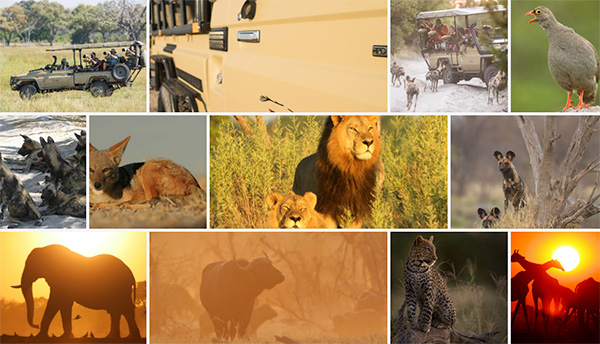
This safari includes:
- Spacious and comfortable tented accommodation, including beds, bed linen and towels, with a private bathroom en-suite.
- Services of a professional guide, safari chef and camp assistants, complete with a supply vehicle.
- Game drives and local transfers in customised safari vehicles.
- Exclusive camping in private campsites within the national parks and reserves.
- All entrance and camping fees within the national parks and reserves.
- All meals and drinks (mineral water, soft drinks, beer, wine and G&T) whilst in our tented camps
- All activities as specified in the itinerary.
- 12% Value Added Tax.
This safari excludes:
- Travel Insurance.
- All flights unless otherwise indicated.
- Items of personal nature.
- Staff gratuities.
- Optional safari extensions.
- Any drinks at lodges or accommodation other than our tented camps.

| Day 1 | After your arrival at Maun International Airport you will be met by Mack Air for your charter flight at approximately 14h00 to the Xakanaxa airstrip in Moremi Game Reserve where you will be met by your guide. |
| Day 2 - 3 | Game drives in Moremi |
| Day 4 | Following and early morning breakfast you take a slow drive through Moremi Game Reserve north-east towards the Khwai Community Area. |
| Day 5 - 6 | We spend the following two nights camping at an exclusive campsite in the Khwai community area, exploring the Khwai floodplains on game drives both during the day and at night. |
| Day 7 | We head further north en-route to Central Chobe region, exploring the desert-like landscape on game drives. |
| Day 8 - 9 | Game drives in Central Chobe |
| Day 10 | We will leave Central Chobe early to travel along the Chobe River arriving in Kasane where we will stop for a picnic lunch before taking an afternoon boat cruise to end the safari. |
Detailed Itinerary
Day 1: Maun - Moremi
After your arrival at Maun International Airport you will be met by Mack Air for your charter flight at approximately 14h00 to the Xakanaxa airstrip in Moremi Game Reserve where you will be met by your guide.
If you are staying in Maun prior to the safari, please request an airport transfer, Mack Air will liaise with your accommodation the day before to confirm the flight departure time. Alternatively, if you are coming from one of the many safari lodges, you can organize to fly directly into Xakanaxa Airstrip with the lodges preferred charter company although we do request that these flights land only after 12h00 in order for our guide to be there to meet you.
Our first three nights are spent in the Xakanaxa region where we explore the surrounding wilderness on morning and afternoon game drive excursions.
Wildlife: From the air only the larger animals are easily seen. These include large breeding herds of African elephant that live in the mopane scrub. On the open plains large herds of buffalo and lechwe can be seen and in the waterways, pods of hippopotamus are a common sight. Once you land in Xakanaxa and board your land cruiser, the smaller game animals can be found.
Birding: A good day for raptors with African Hawk-Eagle, Gabar Goshawk, Shikra, Little Sparrowhawk, Dark Chanting Goshawk, Tawny Eagle, Lesser Spotted Eagle* and Steppe Eagle* all inhabiting the mopane and adjacent woodlands. Other birds common along this route includes most of Botswana’s hornbills including Red-billed, Southern Yellow-billed, African Grey, Bradfield’s and the Southern Ground Hornbills. A large number of brood-parasites may also be seen. Diederick Cuckoo*, Levaillant’s Cuckoo*, Jacobin Cuckoo*, Great-spotted Cuckoo*, African Cuckoo*, Common Cuckoo*, Shaft-tailed Whydah, Pintailed Whydah, Eastern Paradise Whydah, Greater Honeyguide, and Lesser Honeyguide.
Activities: Game Drives
Day 2 - 3: Moremi
Habitat: Moremi lies on the eastern extremity of the Okavango Delta. Habitats here range from wide-open floodplains, marshes, lagoons, papyrus fringed channels, vast stands of Miscanthus and Phragmites, woodland and savannah. As a result of the extremely variable habitat the diversity of both wildlife and birdlife is excellent.
Wildlife: Moremi is amongst the best game reserves in Africa for viewing the endangered African wild dog. Xakanaxa is home to a resident herd of several hundred buffalo whose range covers the territories of at least 4 prides of lion which may often be seen flanking the ever moving herd. Breeding herds of elephant move between their browsing areas in the mopane forests and the fresh water of the Okavango. Red lechwe are one of the more unusual antelope species and commonly found here.
Birding: The swampy areas of Xakanaxa are home to African Rail, Coppery-tailed Coucal, Black Coucal*, Red-chested Flufftail, African Crake*, Black Crake, Chirping Cisticola, Luapula Cisticola, Purple Swamphen, Allen’s Gallinule to name but a few. The open waters attract African Skimmer, Saddle-billed Stork, Yellow-billed Stork, Intermediate Egret, Goliath Heron, African Fish Eagle as well as the globally threatened Slaty Egret and Wattled Crane.
Activities: Game Drives
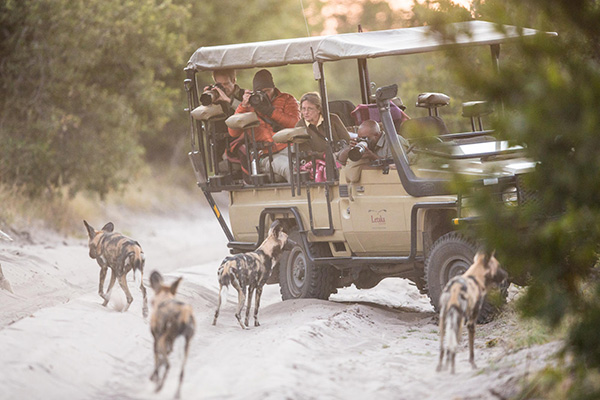
Day 4: Moremi - Khwai
Following and early morning breakfast you take a slow drive through Moremi Game Reserve north-east towards the Khwai Community Area.
Habitat: The Manuchira Channel is known as the Khwai River at its eastern most extremity. The day’s journey follows this water course, with the track weaving from the riverside and floodplains into the mopane veld and the woodlands that make Khwai one of the most scenic areas of the Okavango. We pass the magnificent Dombo Hippo Pools in the morning stopping to enjoy the scenery and the antics of the resident hippo.
Wildlife: The western mopane veld is home to mostly breeding herds of elephant whilst the eastern reaches of Khwai is home to some impressive old bulls. The mature bulls revel in the cool waters of the Khwai and are far more approachable while drinking and bathing than the breeding herds. The river has an unusually high density of hippo as well as some huge crocodile. Leopard, cheetah, serval and lion are common predators along this route and both Xakanaxa as well as Khwai are included in the home ranges of 2 different packs of wild dog. General game includes southern giraffe, Burchell’s zebra, tessebe and red lechwe with roan and sable antelope being less common residents.
Birding: In the mopane woodlands African Hawk-Eagle, Tawny Eagle, Gabar Goshawk, Little Sparrowhawk, African Harrier Hawk and Shikra are common raptors. Mixed bird parties move through the canopy and include Red-headed Weaver, Stierling’s Wren-Warbler, Scarlet-chested Sunbird, Neddicky, Yellow-breasted Apalis, Chin-spot Batis, Diederik Cuckoo* to name but a few. The verges of the swamp form breeding grounds for the Rosy-Longclaw, Black Coucal*, Long-legged Bustard and the African Crake*.
Activities: Game Drives, Night Drives
Day 5 - 6: Khwai
The Khwai River forms a boundary between the reserve and the community area. We spend the following two nights camping at an exclusive campsite in the community area, exploring the Khwai floodplains on game drives both during the day and at night. Exploring after dark with spotlights offers you an opportunity to experience some of the nocturnal animals that are rarely encountered during the day. We will also have the opportunity to explore the surrounding wilderness on foot (please note that this activity is seasonal based on rains and grass height, your guide will determine the safety of walking in Khwai) and mokoro and enjoy an up close and personal encounter with Botswana’s flora and fauna. It is important to note that night drives and guided walks are not permitted within the national parks and reserves. These activities are conducted outside the boundaries of the Moremi Game Reserve in the Khwai community area.
Habitat: We spend our time between the dry-land habitats of the lead-wood and camel-thorn woodlands and savannahs and the riverside and marshy back-waters of the Khwai. Time permitting we may visit the lagoons and waterways of Xakanaxa where the largest heronry in southern Africa exists.
Wildlife: The Khwai region boasts excellent populations of both bull elephant as well as breeding herds. Lion, leopard, serval and African wildcat are common predators of the region with wild dog and cheetah being less common. Buffalo use this area seasonally with large herds moving in during the summer rains. The swampy areas in the west are home to red lechwe. Other ungulates include tsesebe, blue wildebeest, giraffe, kudu, sable antelope, roan antelope and impala.
Birding: Truly one of Botswana birding Mecca’s. The western reaches are prime habitat for the uncommon Rosythroated Longclaw. The entire length of the river is hunting domain for the Bat-Hawk. Other interesting raptors here are Cuckoo Hawk (rare), Long-crested Eagle and Black Sparrowhawk. More commonly Tawny Eagle, Steppe Eagle*, Lesser-spotted Eagle*, Martial Eagle, Bateleur and African Hawk-Eagle. The waterways host Africa Rail, African Crake*, Greater Painted Snipe, Allen’s Gallinule*, Lesser Jacana and Lesser Moorhen*.
Activities: Game Drives, Night Drives, Walking Safaris, Mokoro Excursions
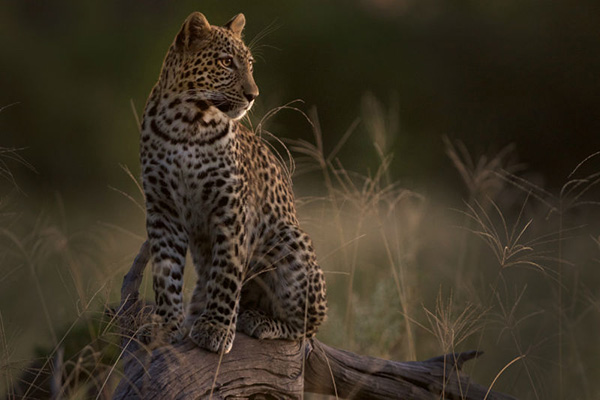
Day 7: Khwai - Central Chobe
We head further north en-route to Central Chobe region, exploring the desert-like landscape on game drives.
Habitat: A fascinating days drive looking at some of the evidence of the Paleo-Lake Makgadikgadi that dried up some ten thousand years ago. The most challenging part of the trip is crossing the Magwikwe Sand-ridge that formed the shoreline for this massive inland sea. The winding track through this deep sand makes for interesting travel in the early summer! The old lake bed is now the Mababe Depression. The dense clay floor of the depression result in high protein feed for wildlife and the area teams with game after the rains. During the rainy season the depression is impassable due to the “cotton soil” and alternative routes must be used.
Wildlife: A day when anything could happen. The range of habitat that is covered encompasses most of the habitat types of northern Botswana. We pass through excellent lion country and some of the best cheetah country that our safari will cover. Elephant occur throughout the drive but are more common at the start and end of the drive where permanent surface water can be found.
Birding: The Mababe Depression is a birder’s paradise. The nutritious grasses that grow on the rich soils provide excellent seed for an impressive array of estrillids and viduids. Among these are the magnificently coloured Violet-eared Waxbill, Black-cheeked Waxbill, Village Indigobird, Shaft-tailed Whydah and Paradise Whydah. These in turn provide a good food source for small raptors such as the Little Sparrowhawk, Shikra, Gabar Goshawk, Red-necked Falcon and Lanner Falcon. It is not only the small birds that feed on the grass seeds, but rodents too. There are annual outbreaks of huge numbers of rats and mice. As a result, huge numbers of Secretary Bird, Tawny Eagle, Black-shouldered Kite, Steppe Eagle*, Lesser-spotted Eagle*, Wahlberg’s Eagle* and Steppe Buzzard* can be found.
Activities: Game Drives
Day 8 - 9: Central Chobe
Habitat: Unlike the vast majority of the country, Central Chobe is not a totally flat landscape. Large outcrops of volcanic rock reach up out of the Kalahari sands, towering over the endless savannah. These hills provide habitat for a completely different array of small wildlife, birds and plants. The Savuti Marsh has been the stage for many of the most dramatic wildlife documentaries in Africa. The wide open country, good ungulate populations and particularly strong prides of lion and hyaena clans make for dramatic wildlife interaction and excellent viewing opportunities. The now dry Savuti Channel runs through this landscape linking the dry sand-veld, the waterholes, the hills and the grassland that was the Savuti Marsh.
Wildlife: Undoubtedly it is the interaction between lion and elephant that is the most interesting aspect of Savuti. The area is inhabited by a huge pride of lions with numbers fluctuating from 20-30 members. These remarkable lions have learned over the years how to hunt these massive pachyderms that are supposedly above predation. Launching their attack under darkness and using their numbers, they manage to kill adolescent and even young adult elephant. The marsh is prime cheetah country and in the wet season it is not unusual to have the wild dog hunting here in Central Chobe.
Birding: The surface water that is pumped by the Government here provides a major attraction for birdlife. In the dry season thousands of dove and sandgrouse come down to drink in the mornings and are under constant surveillance by Yellow-billed Kite*, Tawny Eagle and African Hawk-Eagle. Red-crested Korhaan are common in the Kalahari Apple-leaf (Lonchocarpus nelsii) veld. The marsh is the summer home for good numbers of Caspian Plover* and Montague’s Harrier* as well as Chestnut-backed Sparrowlark, Grey-backed Sparrowlark, Northern Black Korhaan, Rufous-naped Lark, African Pipit and Desert Cisticola. Dickenson’s Kestrel, Amur Falcon* and Red-necked Falcon are found along the perimeter of the marsh.
Activities: Game Drives, Bushman Painting Walks
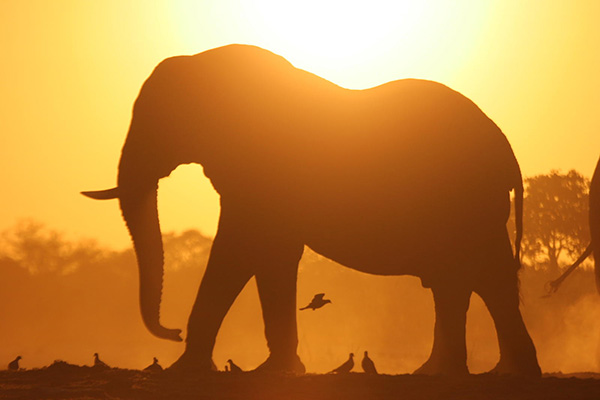
Day 10: Central Chobe - Chobe River
On our final day on safari we will leave Central Chobe early to travel along the Chobe River arriving in Kasane where we will stop for a picnic lunch before taking an afternoon boat cruise to end the safari. As today is a long day we recommend either spending a night or two in Kasane at Chobe Safari Lodge or two nights in Livingstone at Taita Falcon Lodge or Victoria Falls at Ilala. For those transferring to lodges in Kasane or across to Zambia/Zimbabwe it is recommended that your transfer be organized to meet you at Kalahari Tours at 15h30.
Habitat: The habitat on today’s drive takes us through the stunted mopane scrub of the Goha clay basin, across the sand-ridge and through the wonderful Zambezi teak woodlands of the Chobe Forest Reserve and along the Chobe River itself. The Chobe floodplain is tens of kilometers wide and in years of exceptional rains the water stretches as far as the eye can see.
Wildlife: While there are community areas that we pass through that are settled by local tribes, for the vast majority of the day’s drive we pass through wild country where wildlife moves un-inhibited by fences or man. Roan and sable antelope thrive in the teak woodlands where the low density of predators and lack of competition for food by other ungulates makes this prime habitat for these large ungulates. Leopard occur in these woodlands in low numbers but they are highly secretive and seldom seen. The Goha region has natural waterholes that hold water well into the dry season and herds of buffalo, Burchell’s zebra, greater kudu and elephant come down to drink.
Birding: The most unusual species are to be found in the teak (Baikea plurijuga) woodlands. This broad-leafed woodland, or miombo as it is locally known, provides good pickings for insectivorous birds that favour canopy habitat. Grey Tit-Flycatcher, Ashy Flycatcher, Paradise Flycatcher, Pallid Flycatcher, Scarlet-chested Sunbird, Amethyst Sunbird, Yellow-throated Petronia, Red-headed Weaver and Violet-backed Starling are only some of the species that move around in the “bird parties” in the canopy. Dickenson’s Kestrel, Red-necked Falcon, Peregrine Falcon* and Lizard Buzzard are some of the raptors to keep an eye out for, while the diminutive White-faced Owl can often be seen roosting in the road-side vegetation. Flappet Lark, Fawn-coloured Lark, Dusky Lark*, Olive-Tree Warbler* and Neddicky are species more likely to be enjoyed by the birding enthusiast.
Activities: Game Drives, Boat Trips
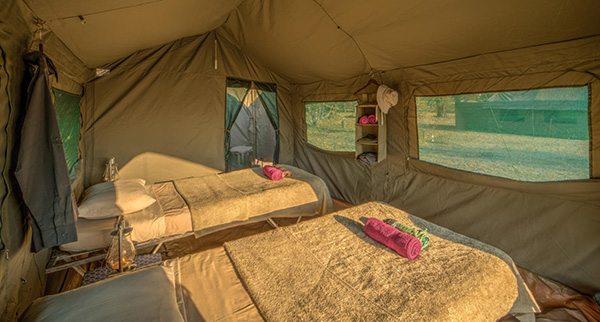
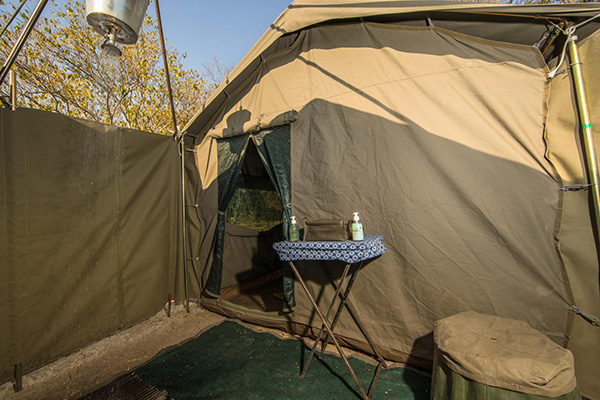
The tents are 4 x 3m Sahara style tents with high roof with a 2 x 3m en-suite bathroom and a 2 x 3m covered area in front of the tent. The tents are fitted with solid base camp beds made up with mattresses, sheets, duvets and pillows. The tents have en-suite long drop toilet facilities and a bucket shower at the rear of the tent. Showers can be ordered as hot, cold or warm and the water is heated in a bucket on the fire. Showers may be taken at any time but on Kalahari safaris the guide withholds the right to limit water use and showering depending upon the availability of water. Both hand towels and bath towels are supplied for the guests’ convenience but please note that guests should bring their own personal items and toiletries.
Each tent has an oil/paraffin lamp on the veranda and in the bathroom and within the tent itself, a LED rechargeable camp light is supplied along with a side table in the sleeping area and in the bathroom. Although each tent has lighting and there are lamps strategically around the camp for navigation, an essential tool for your safari is a headlamp which lets you read a book at night in your tent or catch up with your safari journal as you listen to the sounds of the wild outside! If you don’t buy it from us make sure you buy it from someone and take our advice – don’t pack the free headlamp you got at the supermarket with your battery purchase. Spending a little bit of money will save you a lot of frustration. If you are travelling as a couple then pack one per person.
For families travelling with younger children on private trips, Letaka Safaris have designed a family safari tent, ensuring the children’s safety and their parent’s peace of mind. A family tent is a two-bedroom unit with an adjoining bathroom and lockable exit/entrance with each tent taking 2 people in each.





